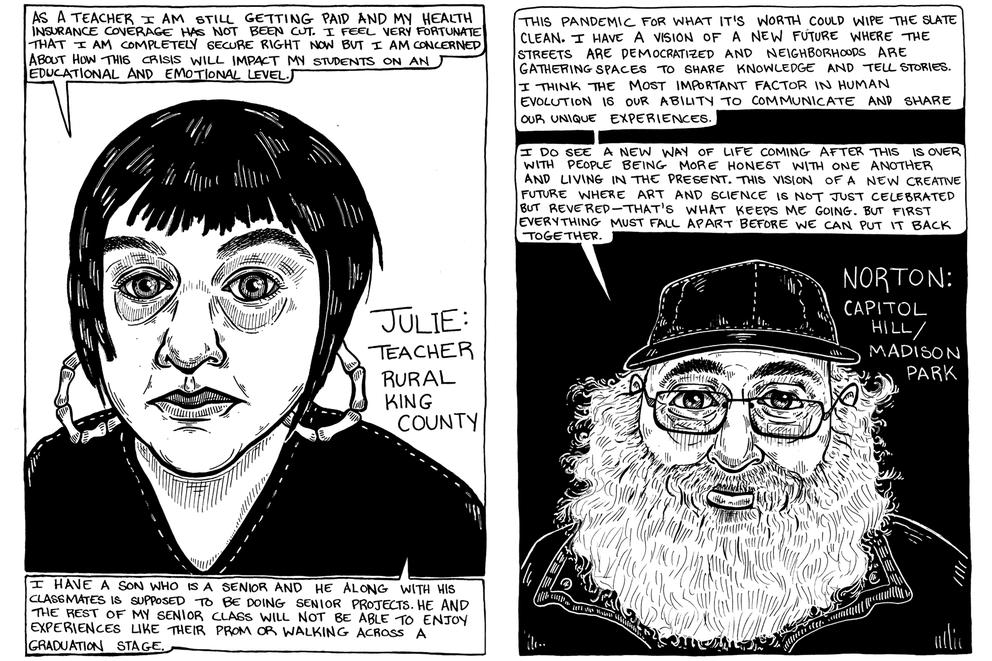Spring rites and rituals have been on my mind this week, since learning the next installment in Seattle Symphony Orchestra’s fantastic series of video broadcasts will be Stravinsky’s masterpiece, Rite of Spring (April 30 and May 2-3; free on YouTube and Facebook). One of the 20th century’s most influential pieces of music, Rite of Spring is famous for inciting an audience to riot when first performed in 1913 — the composition was simply too radical to withstand. The SSO’s performance of the piece this past November is famous in my mind for the internal riot I experienced after waiting too long to get tickets (sold out!).
I’m excited to be able to see what I missed, even if on a far smaller scale than Benaroya Hall. In addition to the musicianship, rave reviews lauded maestro Thomas Dausgaard’s expressive conducting, as well as the accompanying performance by Juliana & PAVA, a local vocal ensemble that performs ancient Russian folk songs. The unsettling power of the score is deepened after hearing the source melodies and themes, which Stravinsky sliced and diced into his legendarily discordant mix.
Rite of Spring is featured in Fantasia (1940), Disney’s animated ode to iconic classical music, accompanied by imagery depicting the formation of the earth, the extinction of dinosaurs and a massive earthquake. Clearly, the music invokes tectonic shifts, which makes it the perfect soundtrack for a pandemic.
This spring we’re learning new rites — donning masks to go grocery shopping, holding happy hours on Zoom, dancing a defensive do-si-do with fellow pedestrians. They say it takes 21 days of repetition to build a new habit, but here in my eighth week of sheltering in place, these actions still feel odd and unfamiliar to me.
Some of our new rituals are a lot more fun, especially as artists develop creative workarounds amid isolation. This week Crosscut reporter Margo Vansynghel wrote about Seattle dance company LanDforms, which has created a new kind of “drive-in dance” performance. In the piece Cooped-Up (the first two weekends have sold out, but more are in the works), ticketed audience members receive a map and a downloadable soundtrack with guidance for driving to seven miniperformances. Once parked, viewers watch from their cars as dancers use their own balconies, yards and windows as a stage.
Rather than a spontaneous 1960s-style happening, this is a highly orchestrated affair. A choreographer coordinates every minute from home, via multiple screens and phones, like an air traffic controller. The dancers hope to continue this new concoction of treasure-hunt-meets-performance-art even after the stay-at-home order has been lifted. They like how this level of audience involvement activates the work in new ways.
One of the multitude of things we can’t predict right now is which new rituals will stick around post-coronavirus, and which will fall away as artifacts of a strange era.
That’s why the Washington State Historical Society has put out a call to “document COVID-19 history for the future.” The archive is asking people to send evidence of this time — such as homemade face masks, screenshots of Zoom calls, diaries, photos and written anecdotes — so as to track history as it happens (send to digitalarchive@wshs.wa.gov). The hope is that future generations wondering what everyday life was like during this pandemic will get a fuller sense by delving into our experiences.
Another effort to capture this moment in time is that of Seattle illustrator Julia Wald. This week I wrote about how the artist is documenting the everyday upheaval of coronavirus by interviewing people in various states of job insecurity (prep cook, health care worker, teacher, musician, social worker, someone living homeless), then translating their responses into bold black-and-white comics. It’s a kind of graphic reportage that stands out for its artistry but also the view it offers into a societal moment of uncertainty. As Wald says, “I’m interviewing people about their day-to-day emotional responses and lives — normal stuff — in an extraordinary time.”
I’ve been tracking the new rites of the pandemic by documenting the way artists are responding, but also personally. Last week in Time magazine, author Katherine Sharp Landdeck argued we should all be keeping coronavirus journals. “Now we are part of our own historical moment in time, a period that historians will debate for decades, even centuries to come,” she says. “Our chance to control some of that narrative is in our hands.” At the same time, she cautions against anticipating what historians would want to hear. “We should write first for ourselves — an honest release at the end of the day.”
In my notebook I jot down the new phrases we are all using, so I can remember they once felt strange in my mouth: socially distanced dinners, flattening the curve, a dial not a switch. It all seems unforgettable right now, but I know in the future my memory will cloud. I’ll lose track of the daily drudgery of our upheaval. How it feels in the body to resist hugging a friend. The new melancholy underlying bright bursts of flowers.
For weekly updates from Brangien about the shifting landscape of local arts amid coronavirus, subscribe below.
Get the latest in local arts and culture
This weekly newsletter brings arts news and cultural events straight to your inbox.








